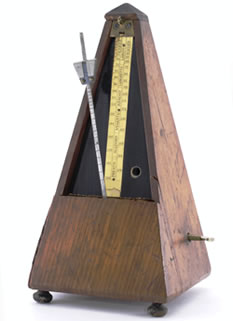Why Can’t I use a Regular Metronome?
Why Can’t I use a Regular Metronome?
 Some parents have asked me if they could just use a regular musical metronome and get the same results as Interactive Metronome at home or IM-Home. A standard metronome is typically used by musicians to help them practice the tempo of music. They have also been used in traditional therapy to help patients with their timing and rhythm, however there is one piece that is missing. – FEEDBACK!
Some parents have asked me if they could just use a regular musical metronome and get the same results as Interactive Metronome at home or IM-Home. A standard metronome is typically used by musicians to help them practice the tempo of music. They have also been used in traditional therapy to help patients with their timing and rhythm, however there is one piece that is missing. – FEEDBACK!
The traditional metronome was developed in the early 1800’s by Johann Maelzel using the precise movements of a pendulum to create the tempo or “beats” and is measured per minute. So while the movement and the timing of the metronome is precise, it gives you no direct feedback to help you monitor your own timing. Although it might look right to you, measurements in milliseconds are tough to spot!
I love to have the parents of my patients come back to our IM room and try IM out themselves. They are amazed at how difficult it is to keep on the beat! It’s at that point that they realize just how hard their children are working. When you work to keep your timing with in 15 milliseconds of the beat, you get a brain workout! I can remember when I completed my initial IM training, my brain just felt like mush!
Now when you are at home, working on activities to reinforce what your child is doing in IM, using a regular metronome, or even one of the free ones online, you can try doing exercises to a beat. I ask my families to set the tempo at 54 beats per minute and perform such activities as jumping jacks, claps, cross crawl, patty cakes or toe touches. Or do some teamwork with your child and pass a basket ball back and forth to the beat by tossing or bouncing it. Although you won’t get any true feedback from the metronome, you will be helping your child to establish those newly formed pathways.
In summary, the use of a regular metronome is definitely beneficial, however the part that helps us to really learn is missing. We need the feedback to help us learn and form new neural pathways. Whether you are an auditory or a visual learner, the IM program has the feedback needed.
>


